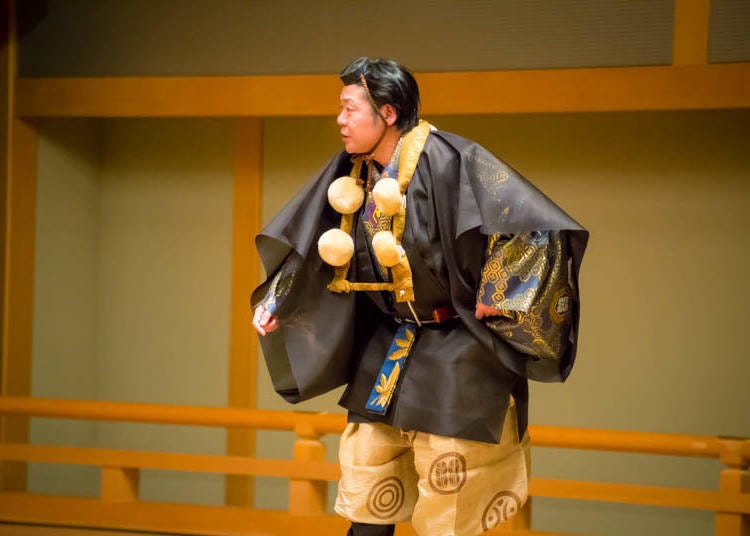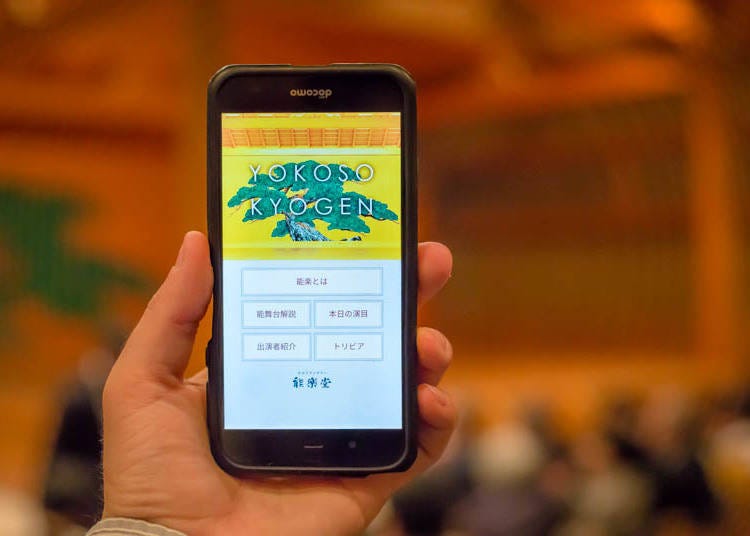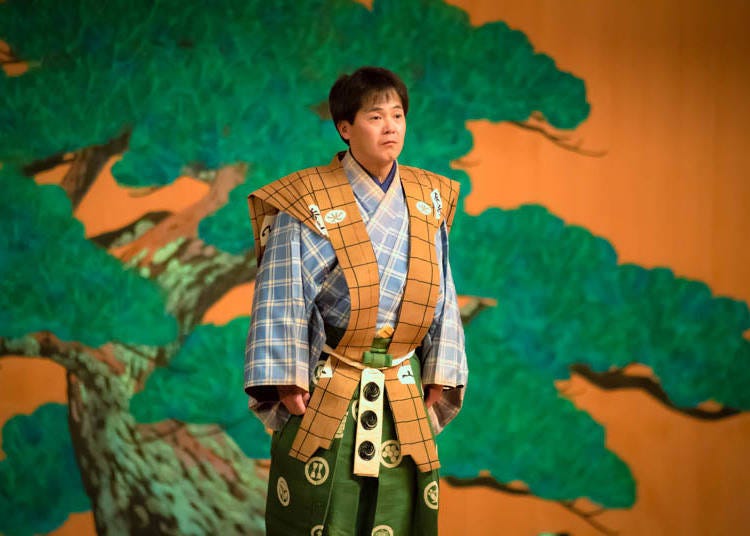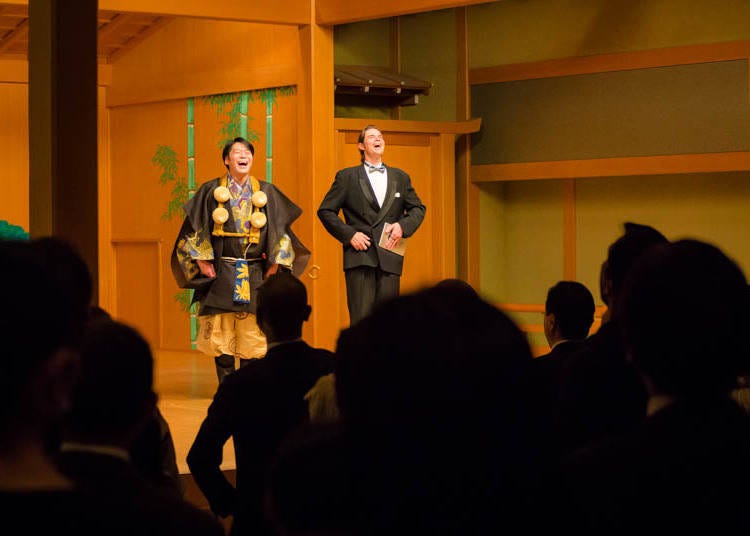![[MOVIE] Traditional Comedy in Japan - Kyogen](https://rimage.gnst.jp/livejapan.com/public/article/detail/a/00/01/a0001118/img/basic/a0001118_main.jpg?20181015112824&q=80)
I wasn’t much of a musical or drama fan while living in the States, but ever since coming to Japan, I can’t seem to get enough of Japanese performances and theater. Kabuki, which is frequently painted on Japanese souvenirs and known around the world, is one of the most popular Japanese theatrical performances. However, I did not know until recently that many kinds of plays have been present for hundreds of years in Japan. One of them is Kyogen (a type of Noh comedic performance). It has a history of over 600 years within Japanese tradition and even registered as a UNESCO intangible cultural heritage. Fortunately, I was given the chance to see a Kyogen play at the Cerulean Tower Noh Theater in Shibuya.
Cast: Manzo Nomura, Thane Camus, etc.
But the Play is in Japanese, Right?

When I arrived to the theater, I was worried about the language barrier as the drama is all in Japanese and I might not be able to catch what they were doing in front of me. I began to wonder if I would be able to enjoy it without understanding it. At this point, I asked my Japanese friend who accompanied me to the theater and she said that she could not understand the dialogue either! Then realized why she was looking up the play online and researching the storyline.
Not only limited to Japan, but also around the world, I believe it is important to look up the storyline as well as some points and manners to observe at the theater in advance. However, we were in luck! The Kyogen performance at the Cerulean Tower Noh Theater provided everyone with a special application called “Omotenashi Guide” to support all foreign guests attending the play.
Watching the Play with Smartphone App Support!


It is usually an important manner to power off your mobile phone while watching a play in a theater. However, this time all the guests and myself were allowed to hold our phones in our hands and enjoy the performance with the downloaded “Omotenashi Guide” app.
After I sat down in the solemn atmosphere of the Noh Theater, I launched the application on my smartphone. Thanks to the application, I was able to read up on some history behind Kyogen, the stage layout, and various Kyogen trivia. When the play finally began, the application showed ever more information with surprising accuracy!
Each time the scene of the play changed, the smartphone vibrated to notify me and gave a description of the scene in English (available in other languages too!). This was very interesting and eased my worries of understanding the play. I was able to focus on the stage performance and my smartphone on occasion, but I was able to fully comprehend and understand the story being played in Japanese in real time. Thanks to this, I was able to laugh with the other guests and locals. I was pretty impressed with the “Omotenashi Guide” app. Even though the service launched only recently, there are 30 locations that provide service throughout the country. I’m sure that more and more services for tourists visiting Japan will only begin to grow!
Things You Should Know Before Theatergoing

Thanks to this experience, my understanding of Kyogen was significantly deepened, so I would love to share some of the knowledge I gained with you on how to enjoy watching Kyogen even without an application.
It is advised to try to read the story beforehand and to be aware of some of the gestures made by the performers.
The theme of the stories of Kyogen is actually pretty simple, which is “Funny Occurrences of Daily Life”. A slip of the tongue and misunderstandings turn into big affairs, and it could feel comedic at every turn. It is very interesting that the points that were funny at the time when Kyogen began also make modern audiences laugh.
Kyogen is performed by means of words and gestures without large-scale stage setting. The “Kata” (style) is fixed, and characterized by their stylized basic postures of standing and way of walking and vocalization. As an example to express grossly exaggerated feelings, their acting of laughing and crying is easy to understand. When acting a laugh, they use their shoulders, open their mouths wide, and make their voice loud by using their entire body. When acting a cry, they put their hands on their faces, bend over, and cry “waah, waah”. Putting realism aside, their acting is expressed by their fixed “Kata” style, and this artistic style is very important to Kyogen.
In Conclusion

This time, I was able to experience one program, but I am definitely interested in seeing more various Kyogen stories. The character that caught my attention was “Taro Kaja”. The same name appears in a lot of Kyogen plays. He is a typical regular person in the plays. There are also many roles of servants, who serve lords and samurai, wearing typical clothing for the common people at that time, and they play easy-to-like and humorous roles. There are many superiors and their subordinates, colleagues, couples, priests, and yamabushi (mountain priests), and others. They have no specific names, but they are just as memorable.
As costume varies depending on social status, age, occupation, and gender, the position and status of the character can be recognized if you look at the costume.
Beginning hundreds of years ago, the details of this performing art has been passed down to the present. It is certain that theatergoers of this performing art will make a unique and enjoyable experience to all. I recommend it to everyone!
- Area
- Category
*Prices and options mentioned are subject to change.
*Unless stated otherwise, all prices include tax.
Popular Tours & Activitiess
Recommended places for you
-
Ad

(Opening in Jan 2026) 'THE SUMO LIVE RESTAURANT HIRAKUZA GINZA TOKYO!' 5 Exciting Ways to Experience the World of Sumo!
-

Jujutsu Kaisen Takes Over JR East With a Wrapped Shinkansen This Winter
by: Guest Contributor
-

First Japan Cherry Blossom 2026 Forecast Announced! Here's When & Where to See Sakura in Japan
-

Strawberries, Style, and Tokyo’s Coolest Neighborhood: Winter Afternoon Tea in Kichijoji
by: Guest Contributor
-
Ad

[Tokyo, Ueno] A Journey to the Sacred Grounds of the Tokugawa Shoguns: A Complete Guide to the "EDO SHOGUN’S LEGACY TRAIL TOUR" – Where Special Access, Modern Art, and Digital Innovation Converge
by: Guest Contributor
-

This Winter, Godzilla Takes Over Haneda Airport
by: Guest Contributor
Inspiration for Accommodations
-

Enjoy Mt. Fuji from the Comfort of Your Room! Recommended Ryokan with Mt. Fuji View
-

Stay Near the Cherry Blossoms! Hotels for Cherry Blossom Viewing in Tokyo
-

Family-Friendly Hotels with Free Shuttle to Disneyland: Convenient Access for a Magical Stay
-

Top Ranked Hakone Hotels with Mt. Fuji View: Enjoy Stunning Scenery from Your Private Space
-

Convenient Tokyo Hotels with Airport Shuttle: Ideal for Families and Heavy Luggage
-

Stunning Tokyo Tower View Hotels: Enjoy Spectacular Scenery from Your Private Space
-

Convenient Asakusa Hotels with Kitchens: Ideal for Extended Family Visits
-

Experience Luxury: Hakone's 10 Best Five-Star Accommodations
-

Enjoy Mt. Fuji Autumn Leaves! Top Hotels Near the Popular Autumn Leaves Corridor
-

Experience Hakone Fall Foliage from Your Room with Stunning Views
-

Ueno Station Area Guide: Fun Ways to Explore Tokyo's Popular Destination (Area Map & Sightseeing Tips)
-

Secrets to Shopping in Japan: Guide to Annual Sales in Japan & Where to Shop
by: Miyu Shimada
-

Easy Day Trip from Tokyo! Ultimate Sightseeing Guide for Hakone & Lake Ashinoko!
-

8 Unfamiliar (But Totally Normal) Customs in Japan!
-

Essential Tokyo: The Complete Guide to Ikebukuro Station
-

Autumn in Japan 2025: Fall Foliage Forecast & Where to Enjoy the Colorful Leaves (+Tour Info)
- #best ramen tokyo
- #what to buy in ameyoko
- #what to bring to japan
- #new years in tokyo
- #best izakaya shinjuku
- #things to do tokyo
- #japanese nail trends
- #what to do in odaiba
- #onsen tattoo friendly tokyo
- #daiso
- #best sushi ginza
- #japanese convenience store snacks
- #best yakiniku shibuya
- #japanese fashion culture
- #best japanese soft drinks


















